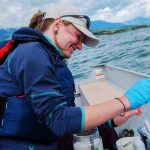In October 2013, 670-million litres of coal mine waste was spilled into Apetowun and Plante Creeks, two tributaries of the Upper Athabasca River. Five weeks later this plume of contaminated water had worked its way downstream into the Athabasca River, the Peace-Athabascsa Delta and into the Northwest Territories. At the time of the spill, it was the largest coal mine breach in Canadian history, now surpassed by the Mount Polley event.
Downstream communities were concerned that heavy metals such as arsenic, cadmium and mercury, as well as hyrdrocarbons would enter the watershed, and the short and long-term impacts that they may have on fish, wildlife and human health. Communities were also concerned that government was not holding industry accountable to its own monitoring response plan, nor conducting impact assessment follow-up monitoring according to federal and provincial standards. To date, no provincial or federal charges have been laid, nor has there been a formal explanation of the contents of the spill, or the impacts to aquatic, ecosystem, and human health.
Living Lakes Canada provided certification training for our partners, The Keepers of the Athabasca, using the nationally accredited Canadian Aquatic Biomonitoring Network (CABIN) protocol. CABIN provides consistent, comparable and scientifically credible data to direct policy, planning and management efforts. We provided support for monitoring, collection of water and soil samples for biological, chemical and heavy metal analysis, laboratory protocols, sample shipment and data management. Due to concerns about inadequate response to the spill including monitoring long term impacts, the Keepers began collecting sediment samples upstream and downstream from the spill in April 2014. Using their increased skills and confidence, the Keepers of the Athabasca were able to gather as a community of concerned citizens and perform water quality monitoring and sediment collection in immediate response to the spill, and collect ongoing monitoring data over time. Benthic invertebrate and sediment sampling has occurred annually at four sites, and in a major project expansion we will be monitoring 12 sites this year.
A collaboration of academic and Non-Government Organizations have come together in response to the spill, to draw awareness about the Obed Mine spill event. The ability for local groups to collect water data independently empowers a dialogue aimed at holding industry accountable and building community capacity. We are working with the University of Alberta to provide data analysis support and determine trends using follow-up monitoring data with the intent to prompt action, should it be required. CABIN data collected will also be used to fill data deficiencies in the WWF Freshwater Health Assessment, an incredible tool used to assess communicate freshwater health.





